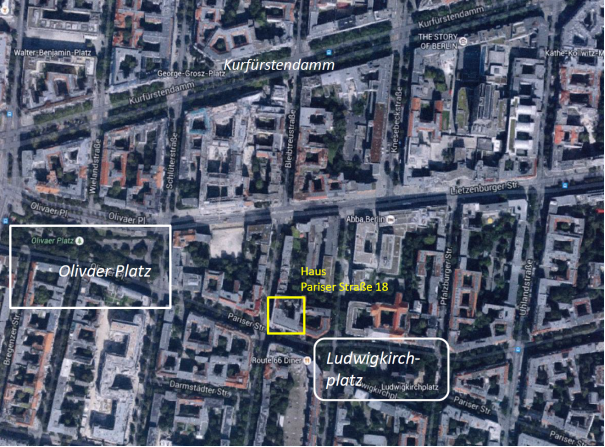The building is at one of the most sought-after and representative locations in Berlin close to the famous Kurfürstendamm.
The corner building is at the intersection of the two quiet residential streets Pariser Strasse and Sächsische Strasse. Just next to the building is the famous Ludwigkirchplatz as well as the Olivaer Platz.
The Ludwigkirchplatz is one of the most popular residential areas in Berlin. The Catholic Church of St. Louis is surrounded by a park. Numerous local and exclusive shops on the square and in the surrounding streets make the area a hot tip for Berlin-visitors and locals.
The most prestigious part of the Kurfürstendamm is only 2 blocks away – merely a few minutes walking distance. In the neighborhood are numerous excellent restaurants, bars, small shops, the flagship stores of international top designer such as Louis Vuitton, Hermes, Gucci as well as the world-famous department store KaDeWe.
The district Charlottenburg-Wilmersdorf is in the center of Berlin and borders on Berlin-Mitte. It is the 2nd richest district in Berlin beside Steglitz-Zehlendorf, which is outside the center of Berlin.
Berlin – the capital along the Spree river is the home of the German parliament and government as well as many German and international organizations. The city’s attraction is based on its modern infrastructure, educational institutions and growing presence as a business hub. Berlin attracts the highest number of new businesses in Germany and is the federal state with the 2nd highest spending on R&D. It has a dominant positions in industries such as life sciences, media, technology and tourism. Due to its international importance, the proximity to the government and its location in the center of Europe, Berlin becomes more and more the European headquarter for international companies. When the new airport opens end of 2017 or in 2018, the number of intercontinental flights will increase dramatically and will make Berlin even more attractive as a business hub as well as for international organizations and tourists.
National and international investors are increasingly focusing on Berlin since its economy has been the most dynamic in Germany for years. Over the last four years the city has gained 40,000 to 50,000 new resident each year. The Berlin senate revealed beginning of the year that the capital is growing at double the pace that city planners had previously expected. The number of inhabitants is expected to grow from currently 3.6 million to around 4 million in 2030.

